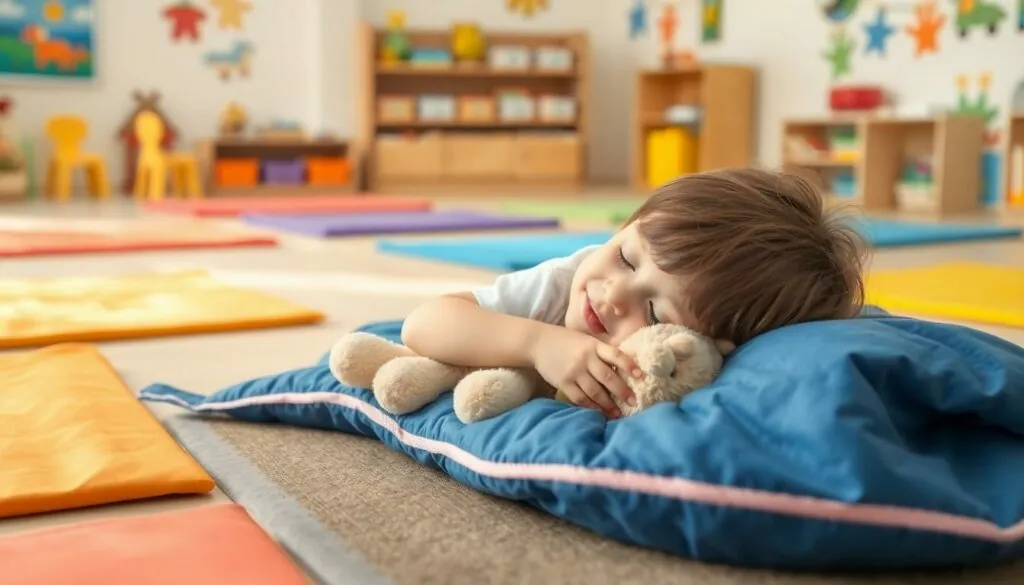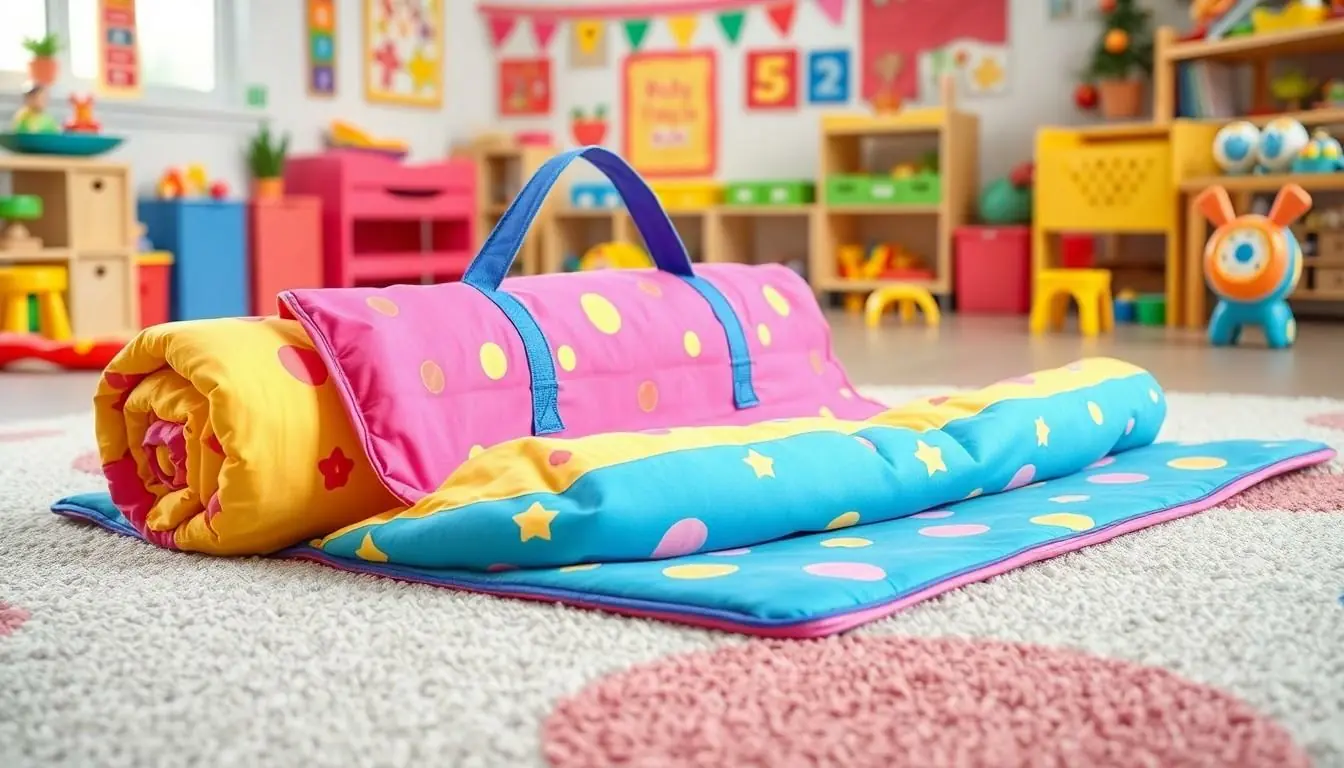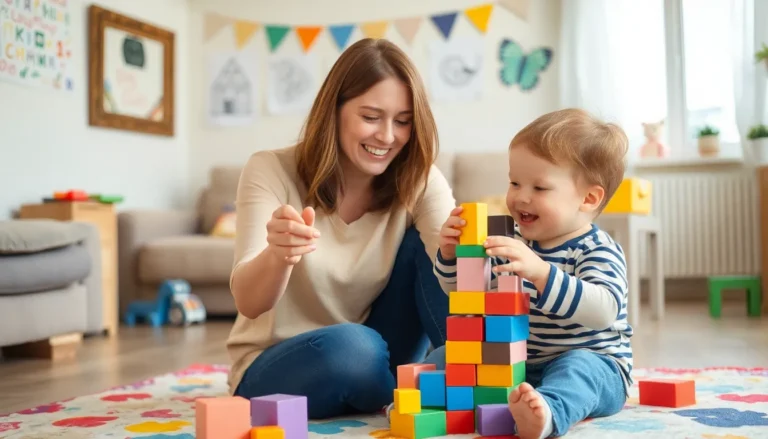Table of Contents
ToggleIn the bustling world of preschool, nap time can feel like a mythical creature—everyone talks about it, but few truly believe it exists. Enter the nap mat, the unsung hero of midday slumbers, transforming chaotic classrooms into serene sanctuaries. Picture this: tiny tots, peacefully nestled in their colorful mats, dreaming of adventures while the world outside spins on.
Importance Of Nap Mats For Preschool
Nap mats play a crucial role in preschool environments by promoting rest and relaxation. They help establish a serene atmosphere for children during nap time.
Benefits For Children
Children benefit significantly from nap mats as they provide comfort and support for restful sleep. Quality sleep enhances cognitive function, allowing children to process information and strengthen memory. Moreover, nap mats create a familiar space where children feel secure, reducing anxiety and helping them transition to sleep. Enhanced mood occurs after naps, as well-rested children typically display increased focus and improved behavior. Engaging in restorative rest also supports healthy development, aiding growth and overall well-being.
Benefits For Educators
Educators experience various advantages from using nap mats in their classrooms. Structuring nap time with mats allows for smoother transitions and less disruption, creating a calming routine. With children resting comfortably, educators can allocate time for planning activities or addressing administrative tasks. Well-rested children exhibit better attention spans, providing educators with a more conducive learning environment. Fostering a nurturing space reflects positively on the classroom atmosphere, promoting collaboration and social interaction among students. Nap mats thus contribute to the overall effectiveness of preschool education.
Features To Look For In A Nap Mat
Selecting the right nap mat involves several key features that enhance comfort and usability for preschool children.
Material Considerations
Choosing suitable materials is vital for nap mats. Quality fabrics, like cotton or polyester blends, provide softness and durability. Parents often prefer hypoallergenic materials to ensure safety for sensitive skin. Additionally, look for mats featuring waterproof or stain-resistant components. This ease of cleaning helps maintain good hygiene in preschool environments. Lastly, also examine insulation properties. Mats with sufficient padding deliver comfort while children rest, minimizing disruptions during nap time.
Size And Portability
Considering size and portability greatly influences a nap mat’s practicality. Nap mats must fit standard cots or sleep areas typically found in preschools. A common size ranges from 20 to 24 inches wide and 46 to 52 inches long, accommodating most preschoolers comfortably. Portability matters as well; lightweight mats with carry handles enable easy transport. Compact designs fold or roll up efficiently, making storage simple when not in use. Always assess whether the mat easily fits in backpacks or cubbies. These features optimize convenience for both children and educators.
Top Nap Mats For Preschool
Finding the right nap mat for preschool provides comfort and support, enhancing children’s rest periods. This section reviews popular brands and compares prices to help educators make informed choices.
Popular Brands Reviewed
- Sleepytime: Known for their plush comfort and vibrant designs, Sleepytime mats feature cotton covers and easy-to-clean materials.
- Munchkin: Offering lightweight options with fun patterns, Munchkin mats are portable and fold easily for storage.
- Wildkin: Specializing in playful themes, Wildkin mats provide durable fabrics and waterproof liners, ensuring long-lasting use.
- Zoe: Zoe mats emphasize eco-friendly materials and hypoallergenic covers, appealing to environmentally conscious parents and educators.
Price Comparisons
| Brand | Price Range |
|---|---|
| Sleepytime | $30 – $50 |
| Munchkin | $25 – $40 |
| Wildkin | $40 – $60 |
| Zoe | $35 – $55 |
Prices vary among brands based on features and materials. Sleepytime mats typically fall within a $30 to $50 range, while Munchkin options start lower at $25. Wildkin’s unique designs result in higher prices, usually around $40 to $60. Zoe mats often cost between $35 and $55, reflecting their eco-friendly focus.
Tips For Choosing The Right Nap Mat
Selecting the right nap mat enhances comfort and relaxation. Consider the material first; cotton or polyester blends provide the necessary softness. Hypoallergenic options cater to children with sensitive skin, ensuring a safe resting environment.
Review the size next. Nap mats should fit standard cots or sleep areas, typically ranging from 20 to 24 inches wide and 46 to 52 inches long. An appropriate size guarantees that children can rest without feeling constrained.
Portability matters greatly. Lightweight mats with carry handles offer convenience for teachers and students. Compact designs that fold or roll up simplify transport and storage, making them practical for preschool settings.
Also, think about hygiene features. Waterproof or stain-resistant qualities extend the mat’s lifespan and ease cleaning. Maintaining hygiene supports a healthier environment, reducing the spread of germs.
Evaluate the design and color options as well. Vibrant designs attract children’s interest, while playful themes can spark creativity and excitement around nap time. Brands like Sleepytime and Wildkin excel in offering appealing options.
Lastly, assess the price range. Sleepytime mats range from $30 to $50, Munchkin from $25 to $40, Wildkin from $40 to $60, and Zoe from $35 to $55. Understanding these variations helps educators budget appropriately while ensuring quality.
By acknowledging these factors, educators can confidently choose a nap mat that meets the needs of their children, creating a calm and restful atmosphere during nap time.
Conclusion
Selecting the right nap mat for preschool is essential for fostering a peaceful environment where children can recharge. By prioritizing comfort, size, and portability, educators can ensure that nap time becomes a cherished part of the day. The right mat not only supports children’s well-being but also enhances their overall learning experience.
With various brands available, finding a mat that meets specific needs is easier than ever. Investing in quality nap mats pays off in the long run, as well-rested children exhibit improved focus and behavior. Ultimately, a thoughtful choice in nap mats contributes to a nurturing atmosphere that benefits both children and educators alike.








